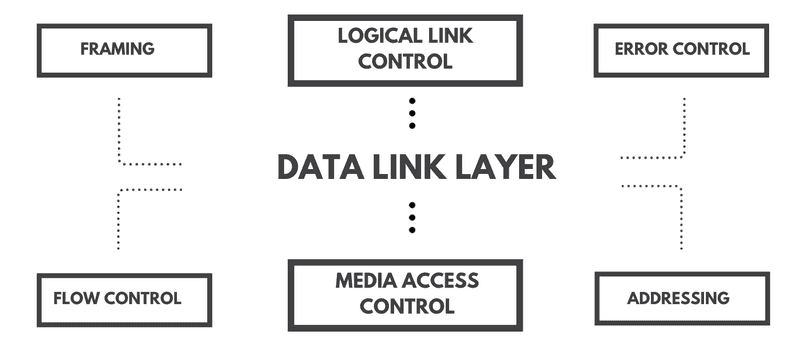TCP/IP Model: The Data Link Layer: Introduction
To properly learn something, we have to start at the beginning. We will be learning one concept at a time, process it, and move to the next.
The goal is consistent learning and absorbing information while feeling engaged and not overwhelmed.
I have divided the data link layer articles in five parts.
- Introduction to Data link layer
- Error Detection and Correction in Data link layer
- Flow and Error Control in Data link layer
- Protocols used in Data link layer
- Switches in Data link layer
Goal of this article
I will be giving the introduction of the data link layer of the TCP/IP Five-layer network model.
The Data Link Layer
-
The second layer of the TCP/IP Five-layer model is the data link layer.
-
The data link layer contains information in the form of frames.
-
The data link layer hides the details of the underlying hardware and represents itself to the upper layer as the medium to communicate.
-
Sender side: The data link layer is responsible for converting data stream to signals bit by bit and sending that over the underlying hardware.
-
Receiver Side: The data link layer picks up data from hardware that are in the form of electrical signals, assembles them in a recognizable frame format, and hands them over to the upper layer.
-
Data link layer is sub-divided in two layers:
- Logical Link Control: It deals with protocols, flow-control, and error control
- Media Access Control: It deals with actual control of media
Functions of Data Link Layer
Framing
-
Receiver side: The data link layer picks up signals from hardware and assembles them into frames.
-
Sender Side: The data link layer takes packets from the network layer and encapsulates them into Frames. Then, it sends each frame bit-by-bit on the hardware.
-
A-frame consists of a data field, in which the network-layer
datagram is inserted, and several header fields. The structure of the frame is specified by the data link layer protocol.
Addressing
-
The data link layer is implemented in a network adapter.
-
Network adapter is a single, special-purpose chip that implements many of the data link layer services (framing, link access, error detection, and so on). Thus, much of a link-layer controller’s functionality is implemented in hardware.
-
The data link layer provides layer-2 hardware addressing mechanism.
-
The hardware address is assumed to be unique on the link. It is encoded into hardware at the time of manufacturing.
Error Control
-
Sometimes signals may have encountered problems in transition and the bits are flipped. These errors are detected and attempted to recover actual data bits.
-
The data link layer also provides an error reporting mechanism to the sender.
Flow Control
- The Data-link layer ensures flow control that enables machines to exchange data at the same speed.
Link access
-
A medium access control (MAC) protocol specifies the rules by which a frame is transmitted onto the link.
-
For point-to-point links that have a single sender at one end of the link and a single receiver at the other end of the link, the MAC protocol is simple (or nonexistent)—the sender can send a frame whenever the link is idle.
-
When a host on the shared link tries to transfer the data, it has a high probability of collision(multiple access problem). The Data-link layer provides mechanisms to equip the capability of accessing a shared media among multiple Systems. Here, the MAC protocol serves to coordinate the frame transmissions of the many nodes.
Did you find this post useful?
I would be grateful if you let me know by commenting below. Means a lot to me!
Sign up to get updates when I write something new. No spam ever.



Comments